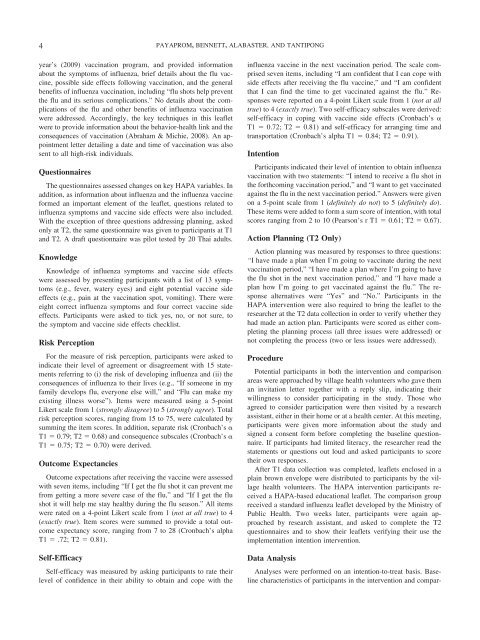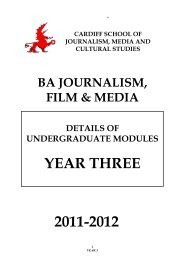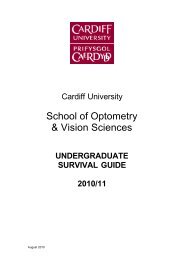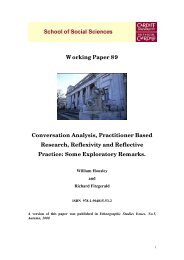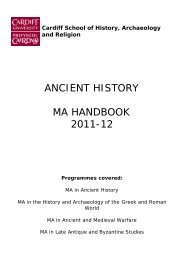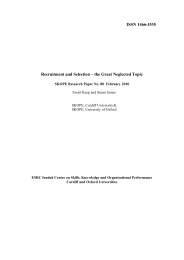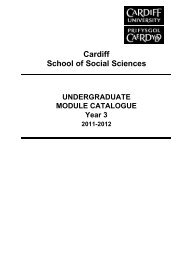Health Psychology - Cardiff University
Health Psychology - Cardiff University
Health Psychology - Cardiff University
You also want an ePaper? Increase the reach of your titles
YUMPU automatically turns print PDFs into web optimized ePapers that Google loves.
4 PAYAPROM, BENNETT, ALABASTER, AND TANTIPONG<br />
year’s (2009) vaccination program, and provided information<br />
about the symptoms of influenza, brief details about the flu vaccine,<br />
possible side effects following vaccination, and the general<br />
benefits of influenza vaccination, including “flu shots help prevent<br />
the flu and its serious complications.” No details about the complications<br />
of the flu and other benefits of influenza vaccination<br />
were addressed. Accordingly, the key techniques in this leaflet<br />
were to provide information about the behavior-health link and the<br />
consequences of vaccination (Abraham & Michie, 2008). An appointment<br />
letter detailing a date and time of vaccination was also<br />
sent to all high-risk individuals.<br />
Questionnaires<br />
The questionnaires assessed changes on key HAPA variables. In<br />
addition, as information about influenza and the influenza vaccine<br />
formed an important element of the leaflet, questions related to<br />
influenza symptoms and vaccine side effects were also included.<br />
With the exception of three questions addressing planning, asked<br />
only at T2, the same questionnaire was given to participants at T1<br />
and T2. A draft questionnaire was pilot tested by 20 Thai adults.<br />
Knowledge<br />
Knowledge of influenza symptoms and vaccine side effects<br />
were assessed by presenting participants with a list of 13 symptoms<br />
(e.g., fever, watery eyes) and eight potential vaccine side<br />
effects (e.g., pain at the vaccination spot, vomiting). There were<br />
eight correct influenza symptoms and four correct vaccine side<br />
effects. Participants were asked to tick yes, no, or not sure, to<br />
the symptom and vaccine side effects checklist.<br />
Risk Perception<br />
For the measure of risk perception, participants were asked to<br />
indicate their level of agreement or disagreement with 15 statements<br />
referring to (i) the risk of developing influenza and (ii) the<br />
consequences of influenza to their lives (e.g., “If someone in my<br />
family develops flu, everyone else will,” and “Flu can make my<br />
existing illness worse”). Items were measured using a 5-point<br />
Likert scale from 1 (strongly disagree) to5(strongly agree). Total<br />
risk perception scores, ranging from 15 to 75, were calculated by<br />
summing the item scores. In addition, separate risk (Cronbach’s <br />
T1 0.79; T2 0.68) and consequence subscales (Cronbach’s <br />
T1 0.75; T2 0.70) were derived.<br />
Outcome Expectancies<br />
Outcome expectations after receiving the vaccine were assessed<br />
with seven items, including “If I get the flu shot it can prevent me<br />
from getting a more severe case of the flu,” and “If I get the flu<br />
shot it will help me stay healthy during the flu season.” All items<br />
were rated on a 4-point Likert scale from 1 (not at all true) to4<br />
(exactly true). Item scores were summed to provide a total outcome<br />
expectancy score, ranging from 7 to 28 (Cronbach’s alpha<br />
T1 .72; T2 0.81).<br />
Self-Efficacy<br />
Self-efficacy was measured by asking participants to rate their<br />
level of confidence in their ability to obtain and cope with the<br />
influenza vaccine in the next vaccination period. The scale comprised<br />
seven items, including “I am confident that I can cope with<br />
side effects after receiving the flu vaccine,” and “I am confident<br />
that I can find the time to get vaccinated against the flu.” Responses<br />
were reported on a 4-point Likert scale from 1 (not at all<br />
true) to4(exactly true). Two self-efficacy subscales were derived:<br />
self-efficacy in coping with vaccine side effects (Cronbach’s <br />
T1 0.72; T2 0.81) and self-efficacy for arranging time and<br />
transportation (Cronbach’s alpha T1 0.84; T2 0.91).<br />
Intention<br />
Participants indicated their level of intention to obtain influenza<br />
vaccination with two statements: “I intend to receive a flu shot in<br />
the forthcoming vaccination period,” and “I want to get vaccinated<br />
against the flu in the next vaccination period.” Answers were given<br />
on a 5-point scale from 1 (definitely do not) to5(definitely do).<br />
These items were added to form a sum score of intention, with total<br />
scores ranging from 2 to 10 (Pearson’s r T1 0.61; T2 0.67).<br />
Action Planning (T2 Only)<br />
Action planning was measured by responses to three questions:<br />
“I have made a plan when I’m going to vaccinate during the next<br />
vaccination period,” “I have made a plan where I’m going to have<br />
the flu shot in the next vaccination period,” and “I have made a<br />
plan how I’m going to get vaccinated against the flu.” The response<br />
alternatives were “Yes” and “No.” Participants in the<br />
HAPA intervention were also required to bring the leaflet to the<br />
researcher at the T2 data collection in order to verify whether they<br />
had made an action plan. Participants were scored as either completing<br />
the planning process (all three issues were addressed) or<br />
not completing the process (two or less issues were addressed).<br />
Procedure<br />
Potential participants in both the intervention and comparison<br />
areas were approached by village health volunteers who gave them<br />
an invitation letter together with a reply slip, indicating their<br />
willingness to consider participating in the study. Those who<br />
agreed to consider participation were then visited by a research<br />
assistant, either in their home or at a health center. At this meeting,<br />
participants were given more information about the study and<br />
signed a consent form before completing the baseline questionnaire.<br />
If participants had limited literacy, the researcher read the<br />
statements or questions out loud and asked participants to score<br />
their own responses.<br />
After T1 data collection was completed, leaflets enclosed in a<br />
plain brown envelope were distributed to participants by the village<br />
health volunteers. The HAPA intervention participants received<br />
a HAPA-based educational leaflet. The comparison group<br />
received a standard influenza leaflet developed by the Ministry of<br />
Public <strong>Health</strong>. Two weeks later, participants were again approached<br />
by research assistant, and asked to complete the T2<br />
questionnaires and to show their leaflets verifying their use the<br />
implementation intention intervention.<br />
Data Analysis<br />
Analyses were performed on an intention-to-treat basis. Baseline<br />
characteristics of participants in the intervention and compar-


